It's All Good!
- By Sarat Pratapchandran
- 06/01/18
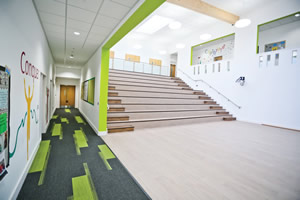
PHOTO COURTESY OF INTERFACE
In Spring of 2001, Prof. Alan Hedge at Cornell University stated that carpets were a safe option for schools. His findings came as school districts nationwide started banning carpets citing an increase in respiratory problems, allergies and asthma. Prof. Hedge was speaking at an annual conference of the Association for Learning Environments (A4LE) in Florida.
He stays true to his views on carpets almost two decades later. The flooring solutions industry has seen rapid changes and numerous options for school designers and planners. “Over the years there has been considerable misinformation about the role of carpet and indoor air quality. Some people still believe that carpet contains respiratory irritants, such as formaldehyde, when this simply is not the case, ” said Prof. Hedge, who is now director of Human Factors & Ergonomics Lab at Cornell.
The carpet industry’s “green label” program has become very tough since the 90s “and consequently modern carpet should not present any problem for indoor air quality.” Carpet’s advantages over smooth flooring materials include good friction so that even with wet soles it is impossible to slip on carpet. Carpet dramatically improves the acoustic environment by deadening impact noises, such as footfalls, objects being dropped on the floor, furniture being moved, etc.
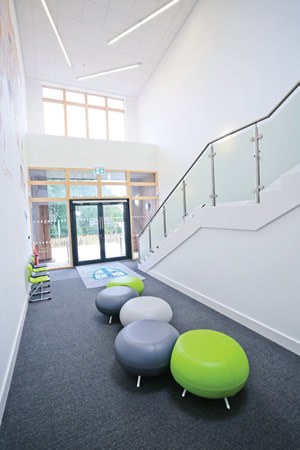
PHOTO COURTESY OF INTERFACE
“The presence of carpet in classrooms has been shown to significantly reduce background noise levels which increases the intelligibility of the teacher for children, especially those at the back of the classroom. For younger children, the ability to sit on carpet is much more comfortable than sitting on a smooth floor surface, “ he said.
Prof. Hedge adds that “vinyl flooring can contain phthalates which have been shown to increase the prevalence of lower respiratory tract symptoms, including asthma. Wet cleaning of smooth floor surfaces also can leave a film of water that acts as a biofilm and that can spread compounds such as endotoxin that can cause adverse respiratory health reactions.”
Today, every flooring option offers its own unique benefits when compared to another.
According to Robert Brockman, Segment marketing manager, Commercial, Armstrong Flooring, resilient flooring covers about half of the market share in education facilities today with carpet declining in recent years to a one-third share. Resilient flooring options include luxury vinyl tile, vinyl sheet, vinyl composition tile, and specialty flooring.
“These shares are generally true for the K-12 segment with carpet experiencing a more significant drop in recent years,” said Brockman.
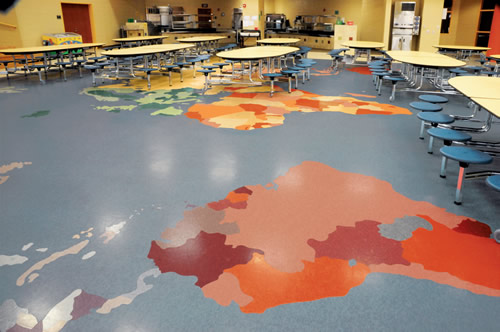
PHOTO COURTESY OF ARMSTRONG FLOORING
According to Brockman, vinyl products have some of the lowest emissions in the flooring industry as they are made from chemically inert materials such as limestone and vinyl.
Vinyl, short for polyvinyl chloride (PVC), must contain a plasticizer to make it flexible. People mistakenly refer to these plasticizers as “phthalates”, but the term “phthalate” is a generic term that refers to a class of chemicals known as “ortho-phthalates”.
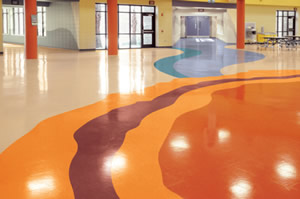
PHOTO COURTESY OF ARMSTRONG FLOORING
He says responsible vinyl flooring manufactures, including his company, Armstrong Flooring, no longer formulate with ortho-phthalates.
“Instead we use bio-based plasticizers or plasticizers containing terephthalates. Plastic drink bottles typically use terephthalates—that is what the “T” in PET stands for—polyethylene terephthalate. The ortho-phthalate-free plasticizers used by Armstrong Flooring are acceptable by both Living Building Challenge and the Well Building Standard.”
Resilient flooring provides enhanced aesthetic values offering unlimited options for designers to choose the look and feel of their spaces. Luxury vinyl tile (LVT) is the fastest growing flooring solution in the K-12 segment today for its color and design flexibility. “The striking realism of LVT and its strong resemblance to natural materials is also a draw for designers,” Brockman said.
Meanwhile, Interface, the largest maker and designer of carpet tile in the world, says carpet tile improves indoor air quality, enhances acoustics, provides underfoot comfort, and strengthens a school’s branding.
Carpet tile eliminates the amount of chemicals in a school, provides flexibility to update and refresh as needed and improves sanitation, as stiff fibers can capture more than 90 percent of dirt and debris. On an aesthetic level, the visual options for carpet tiles are endless.
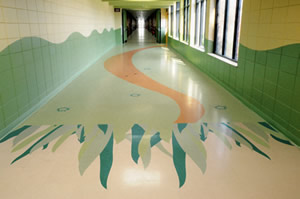
PHOTO COURTESY OF ARMSTRONG FLOORING
“Many of Interface’s flooring collections are inspired by natural elements,” said Wendell Hadden, VP of Education at Interface.
Interface has created a biophilic-inspired space for The Garden School, Hackney, in London, which offers education for two to 16 year olds with highly specialized provisions for learners with autism. Interface created a space that’s calming and restorative for students, using flooring to highlight areas in the space that provide natural light. “The flooring provided tactile references to nature—key to helping students and faculty de-stress, energize and relax,” Hadden said.
When engineering carpet and LVT, Interface takes into special consideration students’ health and wellbeing, designing flooring that is carbon neutral and eliminates chemicals in schools. According to Hadden, the chemical elimination is because Interface flooring does not require any waxing, while a type of flooring that’s been commonly used in schools, Vinyl Composition Tile (VCT), requires wax that contains unsafe chemicals for students. Alternatively, Interface’s carpet tile is protected with its Intersept antimicrobial preservative that’s proven to be extremely safe and effective, and it protects carpet tile from mold growth and odors so it can last longer.
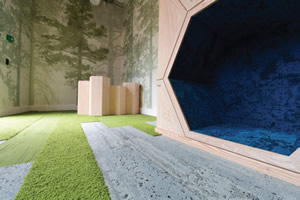
PHOTO COURTESY OF INTERFACE
Meanwhile, another flooring option is premium rubber flooring. “Premium rubber flooring continues to grow in popularity especially in K-12 due to superior cost of ownership without the need of harsh cleaning chemicals, superior indoor air quality, and excellent slip resistance and low noise contribution,” says Tim Cole, vice president of Marketing, nora systems, Inc.
Premium rubber flooring includes natural rubber and man-made rubber. It is supplemented with raw mineral materials from natural deposits as well as environmentally compatible color pigments.
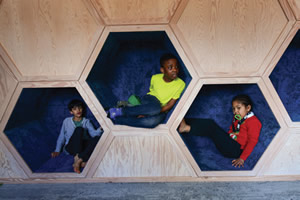
PHOTO COURTESY OF INTERFACE
According to Cole, most rubber floor coverings are free of polyvinyl chloride (PVC), plasticizers (phthalate) and halogens (e.g., chlorine). Rubber flooring does not contain PVC and it won’t generate hydrochloric acid, dioxins or furans, further contributing to enhanced indoor air quality (IAQ) and a healthier environment.
Some rubber floors carry the distinction of being GREENGUARD Gold Certified (formerly GREENGUARD Children & Schools) for low VOC emissions, meeting strict emissions levels required by UL Environment. This certification is broadly recognized and accepted by sustainable building programs and building codes around the world. In the U.S., it’s recognized by The Collaborative for High Performance Schools (CHPS) and the Leadership in Energy and Environmental Design (LEED) Building Rating System.
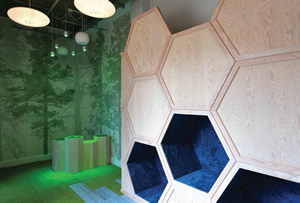
PHOTO COURTESY OF INTERFACE
In addition, rubber flooring installed using solvent-free, environmentally-friendly acrylic adhesives is low-VOC emitting and meets the requirements of the South Coast Air Quality Management (SCAQMD), District Rule 1168 required by LEED.
nora flooring offers more than 300 design and color options, which can work in tandem to tie a building together and create a holistically aesthetic environment.
Using precision ultrasound cutting systems, rubber flooring can create eye-catching seamless inlays with special effects, school logos and design elements to aid in learning. Inlays also offer way-finding properties for younger students as they move from one area of the school to another.
Hard floors are also an important flooring solution for the K-12 sector. According to American School & University’s 29th Annual Official Education Construction Report, published in 2003, the average size of K-12 schools was about 100,000 square feet. Schools normally have about 10,000 square feet of hardwood flooring in gyms, says Brett Miller, VP of Education & Certification for the National Wood Flooring Association (NWFA).
According to market research firm, Catalina Research Inc., in 2016, wood flooring accounted for an estimated 16.6 percent of total floor coverings retail sales. This is up from 13.7 percent in 2012.
Miller cites several advantages for wood floors including easy cleaning, enhanced indoor air quality as they do not harbor allergens and he adds that wood is the most environmentally friendly floor material. The hardwood forests that provide flooring products are growing more than twice as fast as they are being harvested.
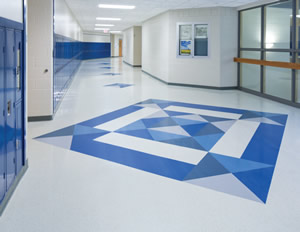
PHOTO COURTESY OF NORA FLOORING
“If cared for properly, the lifespan of a wood floor can exceed 100 years, making it a tremendous value,” said Miller.
However, wood faces two challenges, one is the shortage of qualified skilled workers and secondly, the perception that wood depletes forests or that wood floors are hard to maintain.
According to Miller, hardwood is selectively harvested, removing only mature trees before the tree starts to die. “Removing the taller, mature trees also opens the forest canopy, allowing sunlight to reach younger trees so they can grow to maturity. This process ensures there will be an adequate inventory of raw materials for many centuries to come,” he said.
The NWFA has a Responsible Procurement Program (RPP), a joint initiative between leading environmental groups and industry manufacturers committed to producing and promoting wood floors that come only from environmentally and socially responsible sources, improving forest sustainability for future generations.
Irrespective of which option you choose, most flooring solutions strive to cause little to no harm for occupants in classroom spaces.
This article originally appeared in the School Planning & Management June 2018 issue of Spaces4Learning.